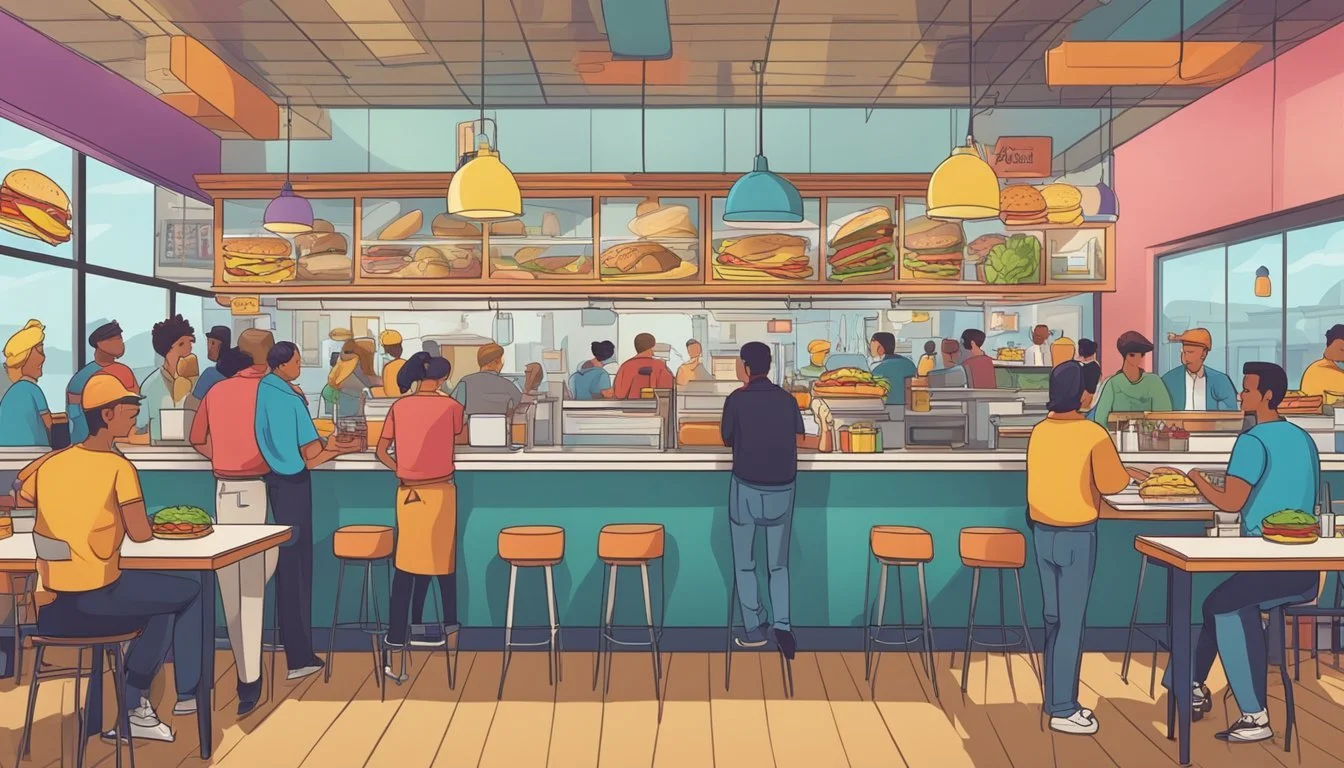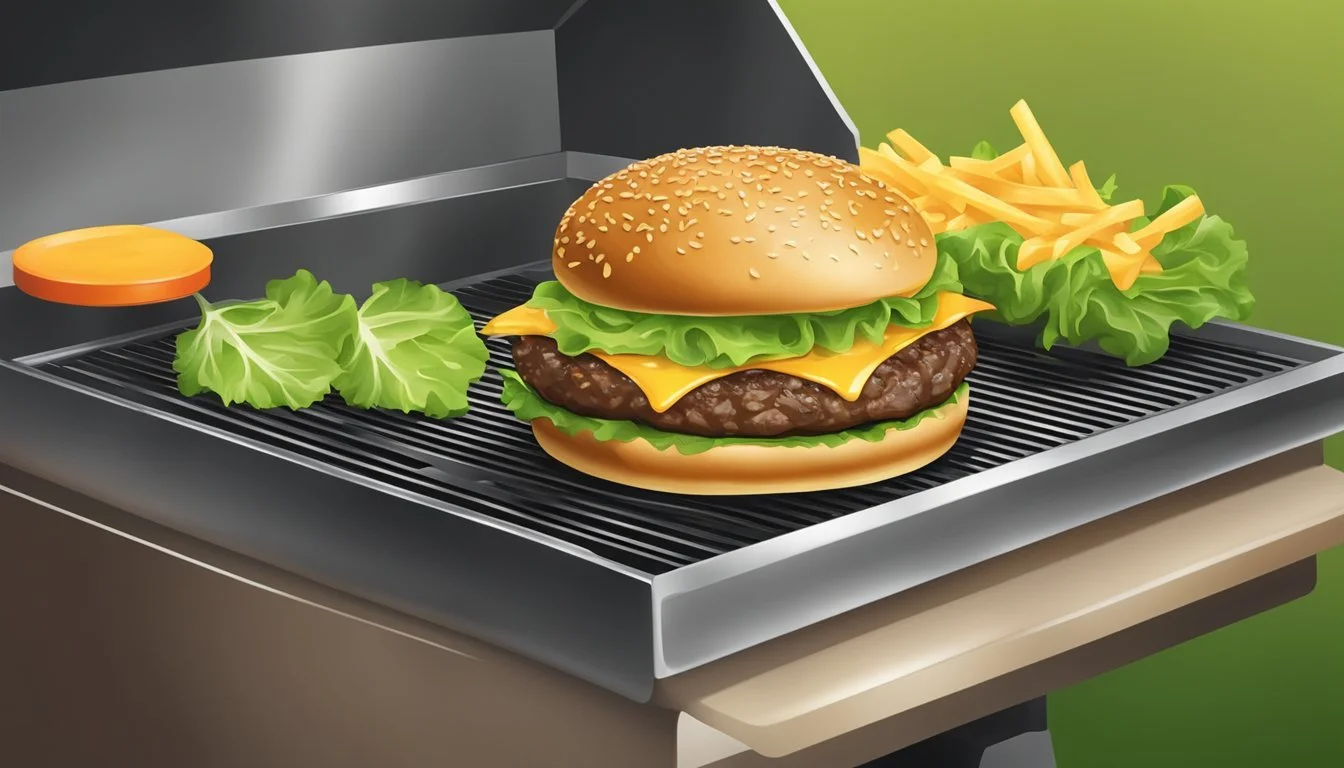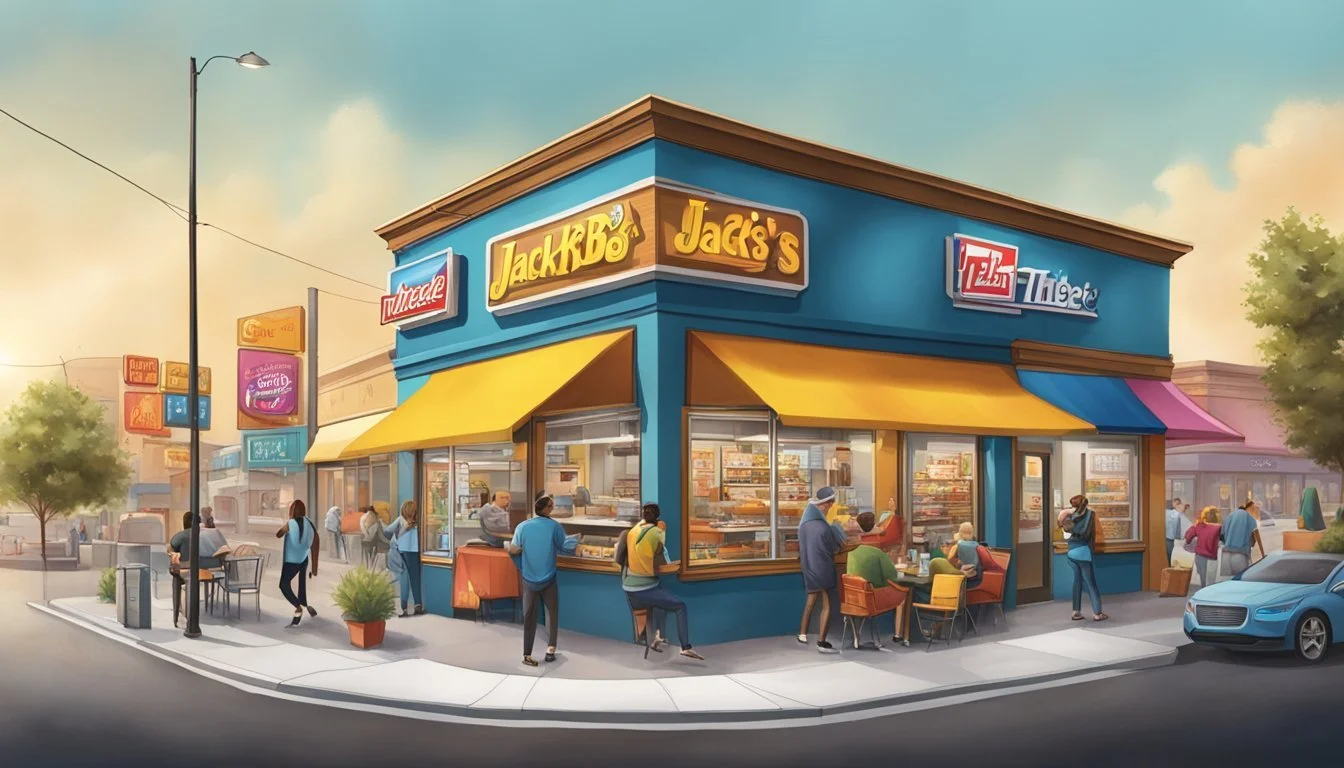Jack in the Box vs Hardee's
Comparing Burger Giants for the Top Spot
When it comes to fast-food hamburgers, customer preferences can vary widely, yet the debate often narrows down to which chain offers the better burger. Jack in the Box and Hardee's, both well-known in the fast-food arena, serve up their unique versions of the classic American hamburger. Each has its own fan base and claims to fame, but a closer evaluation is required to determine which restaurant might come out on top in a head-to-head comparison.
Jack in the Box is recognized for its all-encompassing menu that includes a variety of burgers, amongst other items. The restaurant prides itself on being a place where customers can enjoy a wide selection, from classic burgers to adventurous items like their spicy chicken sandwich or tacos. On the other side, Hardee's, sharing a close relationship in service and menu with Carl's Jr., is known for its Thickburgers and a focus on more robust, charbroiled offerings.
Burger enthusiasts look for several key elements such as patty quality, topping freshness, bun texture, and the overall flavor profile. Both Jack in the Box and Hardee's cater to these aspects in their own ways. While Jack in the Box offers flexibility in choice and variety, Hardee's presents a promise of heartier, burger-focused meals. It's this juxtaposition of diverse offerings versus specialized selections that frames the basic context for this culinary comparison.
History and Brand Overview
The competition between fast-food chains is a tale of branding, market positioning, and historical evolution. This becomes especially clear when comparing Jack in the Box and Hardee's, two establishments with roots deeply entrenched in American fast-food history.
The Genesis of Jack in the Box
Jack in the Box began its journey in 1951, when Robert O. Peterson converted a San Diego drive-in into the first location of what would become a national chain. Its early adoption of a drive-thru window with intercom in the 1950s was revolutionary, giving customers a new and convenient way to order without leaving their cars. As a leader on the West Coast, Jack in the Box quickly established itself as a major player in the fast-food industry, known for its variety in menu and innovative marketing techniques.
Hardee's: The Early Years
Hardee's took a different path, with its roots in the southeastern part of America. Wilbur Hardee opened the first Hardee's in 1960 in Greenville, North Carolina. The early years saw Hardee partnering with James Carson Gardner and Leonard Rawls after facing financial difficulties post-opening, which led to a rapid expansion. By the late 1960s, Hardee's had already established over 200 locations. Eventually, Hardee's would become part of CKE Restaurants Holdings, Inc., a move that linked it with another burger giant, Carl's Jr., under a single corporate umbrella.
Menu Offerings
When deciding between Jack in the Box and Hardee's, a closer examination of their unique signature burgers and menu items reveals distinct approaches to fast-food offerings.
Signature Burgers at Jack in the Box
Jack in the Box boasts an extensive burger menu, with the Sourdough Jack standing out as a fan favorite. This distinctive burger features a beef patty, bacon, cheese, and tomato stacked between slices of toasted sourdough bread. They recently introduced the Smashed Jack, which was developed over two years and has been well received for its juicy and flavorful patty compared to other fast-food options. Jack in the Box’s array of burgers is also customizable with various toppings, including freebies like grilled onions and jalapenos.
Key Burgers Include:
Sourdough Jack
Smashed Jack
Bacon Cheeseburger
Hardee's Unique Menu Items
In contrast, Hardee's differentiates itself with a focus on Thickburgers and its use of 100% Black Angus beef. Notably, the Monster Thickburger—a formidable offering with two beef patties, four strips of bacon, three slices of cheese, and mayonnaise on a buttered bun—is a highlight of their menu. Hardee’s also places an emphasis on charbroiled burgers, adding a distinctive barbecue flavor that resonates with customers looking for a grilled taste. Their sandwiches and burgers come with a variety of bread options, including buns and Texas Toast.
Notable Items:
Monster Thickburger (Monster Angus Thickburger)
Charbroiled Angus Burgers
Various Sandwiches (Chicken, etc.)
Bread Choices (Buns, Texas Toast)
Food Quality and Ingredients
When comparing Jack in the Box to Hardee's, it is crucial to evaluate their commitment to food quality and ingredient standards. Both chains have distinct approaches to beef quality, protein content, and the freshness of their offerings.
Beef and Meat Standards
Jack in the Box often emphasizes variety in its menu, offering a range of beef and meat options to suit different tastes. While specific details on beef grade are not commonly advertised, they provide traditional fast-food burgers that satisfy the standard protein needs of an average meal. Hardee's, on the other hand, has been known for their Black Angus beef, which is a higher-quality beef known for its marbling and flavor. In terms of beef and overall meat standards, Hardee's positions itself as a provider of premium, thicker burgers with a focus on a more discerning customer base.
Freshness and Sourcing
Both burger joints source a variety of ingredients to complement their meat offerings, such as lettuce, tomatoes, and onions. Where sauces are concerned, Jack in the Box provides an extensive selection that includes everything from classic ketchup and mustard to signature sauces. Hardee's tends to focus on the traditional accompaniments but ensures they pair well with their Angus beef burgers.
Freshness is a key component of fast-food quality, and both Jack in the Box and Hardee's strive to provide fresh toppings and sides. The choice of ingredients and suppliers by each chain reflects their broader business model and target market, with Hardee's leaning towards quality as a differentiator, while Jack in the Box positions itself as a one-stop-shop for varied tastes and preferences.
Price Point and Value Comparison
Evaluating Jack in the Box and Hardee's from a pricing perspective reveals various factors that attract different customer bases. Discrepancies in menu pricing and portion sizes play pivotal roles in determining the overall value offered by each burger joint.
Cost-Effectiveness of Meals
Jack in the Box presents a diverse range of prices, with a standard cheeseburger priced at $7.79. In contrast, Hardee's, while not explicitly mentioned in the search results, typically prices their standard cheeseburgers competitively, often comparable to or slightly above fast-food industry standards. Customers have noted that Jack in the Box provides a budget-friendly menu, as some items are nearly 98% cheaper than comparable options at other popular chains, suggesting that Hardee's may have similar cost-effective alternatives.
Size and Filling Factor
Jack in the Box offers substantial portion sizes, as evidenced by the medium onion rings weighing in at 156 grams, with around 11 rings per order. This indicates generous serving sizes, likely translating to their burgers as well. The recognizable Quarter Pounder burger, which is a common benchmark in the fast-food industry, typically signals a satisfying meal size reminiscent of what one may find at either establishment. Hardee's, known for its Thickburgers, also touts considerable burger sizes that aim to satisfy hearty appetites, often including a quarter pound of beef or more.
Marketing Strategies
In the competitive sphere of fast food burgers, Jack in the Box and Hardee's employ distinct marketing strategies to capture their share of the market. Their approaches to advertising and brand positioning play crucial roles in attracting and retaining customers.
Advertising Campaigns
Jack in the Box is recognized for its innovative advertising campaigns. The use of its iconic mascot, Jack, sets a humorous and satirical tone that distinguishes the brand from competitors like McDonald's and Burger King. Notably, their marketing adapts to maintain relevance, as seen by their messaging shifts during the pandemic. In contrast, Hardee's advertising has historically been more provocative, often leveraging bold themes to garner attention. However, both brands utilize social media platforms and television ads to reach wide audiences.
Key Platforms:
Television
Social Media
Print Media
Notable Campaigns:
Jack in the Box: Irreverent humor with the Jack mascot
Hardee's: Bold and edgy themes
Brand Positioning and Presence
Jack in the Box and Hardee's present differing brand images. Jack in the Box, through varied menu offerings, positions itself as a purveyor of comfort foods, catering to a wide range of tastes beyond just burgers, like tacos and egg rolls. This inclusivity in their menu reflects a broader appeal in their brand presence among diverse demographics. On the other hand, Hardee's spotlights its dedication to quality and size with the message "Eat Like You Mean It", emphasizing hearty, indulgent meals that resonate with a segment of the market seeking substantial, satisfying burgers.
Brand Messages:
Jack in the Box: Diverse menu for broad appeal
Hardee's: Quality and size for hearty meal seekers
Market Presence:
Jack in the Box operates primarily in the western and southwestern U.S., creating a strong regional presence compared to the expansive national footprint of chains like Wendy's and In-N-Out.
Hardee's, partnered with its sister chain Carl's Jr., shares similar market coverage but with an added emphasis on the southeastern region of the U.S.
Customer Experience
When choosing between Jack in the Box and Hardee's, patrons weigh factors such as how swift service is and the overall ambience of the restaurants.
Convenience and Service Speed
Jack in the Box is known for its focus on convenience, offering a 24/7 service in many locations, which appeals to customers seeking flexibility. The brand also boasts a diverse menu catering to varied tastes and meal times. Hardee's, sharing operations with Carl's Jr., provides customers with comparable convenience, including drive-thru services which are appreciated for their speed and ease.
Jack in the Box:
Drive-thru availability: Often 24/7
Menu diversity: Breakfast to late-night meals
Hardee's:
Drive-thru availability: Standard hours
Service speed: Quick counter and drive-thru options
Restaurant Atmosphere
The atmosphere within a Jack in the Box restaurant tends to be casual and unpretentious, aiming to match the fast-food dining experience that customers expect. Hardee’s offers a similar atmosphere but often features a slightly more updated and modern decor. Neither establishment typically leans towards a fine-dining ambiance, understanding that the fast-food customer prioritizes efficiency and functionality over luxury dining.
Jack in the Box:
Ambiance: Casual, functional
Hardee's:
Decor: Modern fast-food setting
Nutritional Information
When considering the nutritional aspects of fast food, calories, protein content, and the availability of nutritional information are key factors. Both Jack in the Box and Hardee's offer a variety of burgers that cater to different nutritional needs and preferences.
Caloric Content and Health Options
Jack in the Box features a range of burgers including the Jr. Jumbo Jack which provides a balance of 420 calories, 33 grams of carbs, and 14 grams of protein. This makes it a moderate option for those conscious about caloric intake.
Hardee's, on the other hand, has the Monster Burger, significantly higher in calories, with a single serving totalling 1160 calories and 68 grams of protein. This is a protein-rich option, suitable for consumers with higher energy needs.
Jr. Jumbo Jack (Jack in the Box)
Calories: 420
Protein: 14 g
Source: Jack in the Box
Monster Burger (Hardee's)
Calories: 1160
Protein: 68 g
Source: Hardee's
It should be noted that while these two burgers are indicative of the range available, both chains provide other health-conscious options such as salads and grilled chicken sandwiches.
Transparency in Food Information
In terms of transparency, both Jack in the Box and Hardee's provide nutritional information to help consumers make informed choices. They offer detailed nutritional facts for each menu item, which include calorie counts and macronutrient breakdowns.
Customers can access this information through the respective chain's website or in-store upon request. This transparency allows customers to consider how each burger fits into their individual dietary requirements and preferences.
Expansion and Accessibility
In the competitive landscape of fast food burger joints, Jack in the Box and Hardee's each employ distinct strategies to grow their market presence and ensure their restaurants are accessible to consumers nationwide.
Domestic Growth
Jack in the Box has solidified its presence primarily on the West Coast of the United States, with a notable concentration of locations in California. In contrast, Hardee's operates in different regions, like the Midwest and the Southeastern states, often under the name Carl's Jr. Both chains face stiff competition domestically from industry giants and niche players such as Checkers, Smashburger, and Sonic Drive-In.
Jack in the Box:
Locations: Concentrated in the Western U.S., with over 2,200 outlets.
Competitive Edge: Maintains a diverse menu that ventures beyond typical burger fare.
Hardee's:
Locations: Strong presence in the Midwest and Southeast, with Carl's Jr. branding in the West.
Competitive Edge: Focuses on thicker, often Angus beef based burgers, to differentiate from competitors.
International Reach
While both companies have historically centered their operations within the United States, international expansion is a growing aspect of their business models. Jack in the Box has flirted with expansion into overseas markets but remains a predominantly U.S.-based chain. Hardee's, however, has ventured more confidently abroad with locations in several Middle Eastern countries.
Jack in the Box:
International Presence: Limited forays into foreign markets, mostly remaining U.S.-centric.
Hardee's:
International Presence: Has established franchises in the Middle East, diversifying its global footprint.
Consumer Preferences
In the rivalry between Jack in the Box and Hardee's, consumer preferences play a significant role in determining which burger joint comes out on top. Customers base their decisions on a variety of factors, from taste to brand loyalty and price to convenience.
Trends in Fast Food Consumption
The fast-food landscape is constantly evolving, with trends shaping consumer behavior. For instance, Jack in the Box is known for its diverse menu, which includes a variety of cheeseburgers and quirky late-night offerings. Their approach capitalizes on the trend of consumers seeking variety and unique flavors. On the other hand, Hardee's, while less variety-focused, banks on traditional American fare, emphasizing thick burgers like their classic Thickburgers.
Burger King stands out with its signature item, the Whopper, illustrating the trend that specific flagship products can strongly influence consumer preference. Other chains like Shake Shack and Dairy Queen have carved out their niches with a focus on high-quality ingredients and signature shakes, respectively. Meanwhile, brands like Jollibee, with a distinct cultural flavor profile, cater to a demographic seeking a taste of home or something different from the typical American fast-food burger.
Loyalty and Repeat Business
Brand loyalty is pivotal to the success of any fast-food burger chain. Both Jack in the Box and Hardee's have their share of loyal customers, though each brand attracts a different demographic. Jack in the Box customers often praise the chain's flexibility in meal customization and its broad menu, encouraging repeat visits. On the other hand, Hardee's customers usually cite the quality and size of the burgers as reasons for their loyalty.
Chains like Burger King and Shake Shack have also cultivated a strong base of repeat customers through consistent quality, distinctive branding, and targeted marketing campaigns. These companies illustrate the importance of understanding the target consumer base and leveraging that knowledge to inspire repeat business—the foundation for any brand's success in the highly competitive fast-food industry.
Innovation and Future Directions
In the competitive landscape of fast food, innovative menus and sustainable practices are key differentiators. Both Jack in the Box and Hardee's have taken steps to address these areas.
New Menu Developments
Jack in the Box has been investing in creativity with its menu, exemplified by the release of their first new burger in eight years, the Smashed Jack. Meanwhile, Hardee's showcases its commitment to quality ingredients, with a focus on Angus beef burgers which are associated with a premium burger experience. Both chains are reacting to market trends, offering more sophisticated recipes and diversifications akin to those found at BurgerFi and Chipotle, who are known for their fresh and artisanal approach.
Jack in the Box: Innovative burgers like Smashed Jack.
Hardee's: Premium offerings with Angus beef.
Sustainability and Environmental Impact
Sustainability efforts in the fast food industry are increasingly important. In this vein, rival Burger King's introduction of the Impossible Whopper has spurred the sector to experiment with plant-based options, aiming to reduce environmental impact. While there is no mention of an immediate response from Hardee's or Jack in the Box in the realm of plant-based burgers, such innovations may be on the horizon as they continue to refine their sustainability agendas.
Potential Development: Exploring plant-based options in response to competitors' moves.
Current Effort: Focus on high-quality, sustainable ingredients.










